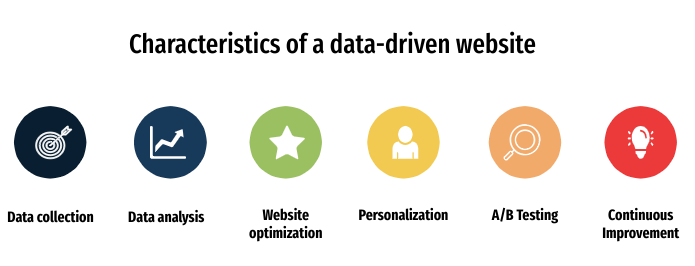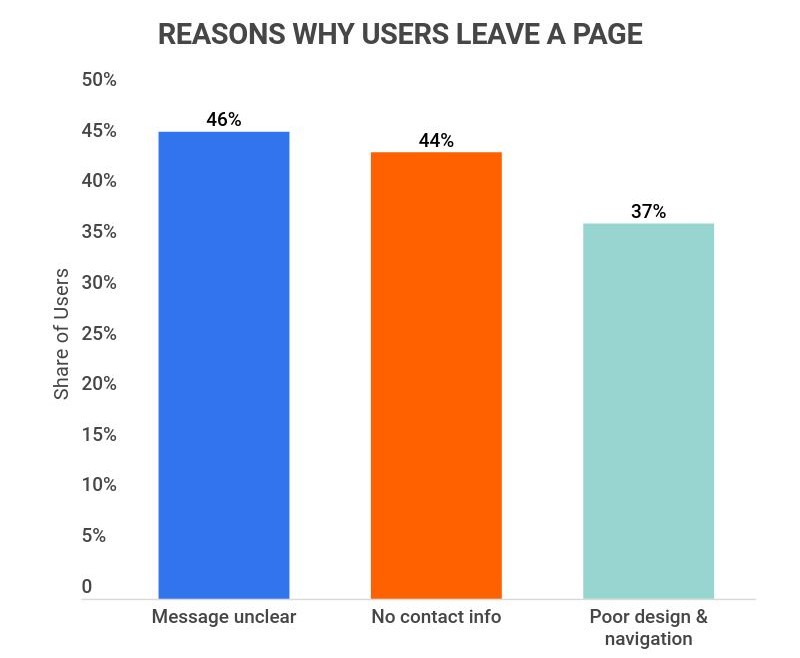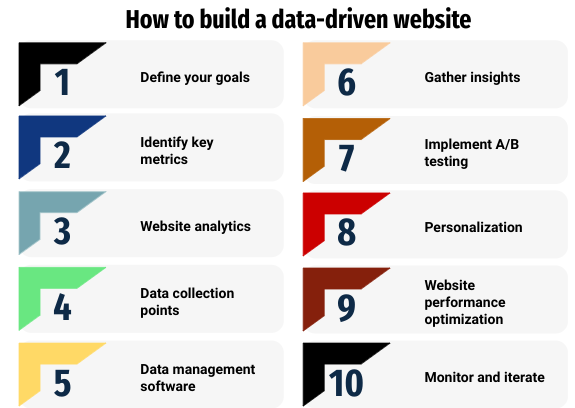You might associate data-driven website development with huge companies or specialist software developers. With more and more accessible, cost-effective data tools on the market, however, data-driven decision-making and websites are on the rise, even for small and medium-sized businesses. If you want to understand what data-driven website development is and how you can implement it, this guide is for you.
What Is a Data-Driven Website?
Data-driven websites leverage and gather data to help their owners make decisions about content, format, and usability. Through the collection, analysis, and utilization of data, a data-driven website can provide a personalized and optimized user experience and help businesses make decisions.

Many companies leverage data-driven website development, from specialist ecommerce stores to VNC server android providers. Some key characteristics of a data-driven website include the following:
Data Collection
Data-driven websites typically have data collection tools built into them. These might include user registration forms, surveys, tracking tools, and APIs (application program interfaces) that allow integrations with other data collection and management tools. The data collected is often user-based, such as user demographics, behavior, and interactions.
Data Analysis
Once your website has collected data, it needs to be analyzed to gain insights, which might help you understand user behavior and trends. This analysis might simply be providing statistics to website owners or using data for machine learning algorithms to extract useful information from the data and even automate processes as a result.
Website Optimization
Data-driven websites often use data to improve page loading times, streamline navigation for users, or improve usability for smartphone users. This is because website data analysis can identify and address user pain points or bottlenecks.
Personalization
By gathering data about individual users, data-driven websites can tailor recommendations or advertisements. This is usually based on individual user preferences, particularly for registered users, or data based on past interactions.
A/B Testing
A/B testing, also known as split testing, compares different versions of a webpage or a feature. By comparing the two, you can evaluate the impact of changes on user behavior, conversion rates, and overall website performance, allowing for data-backed decisions on what works best.
Continuous Improvement
Data-driven website development doesn’t end when a website launches. Instead, it is defined by a cycle of continuous improvement. A data-driven website regularly monitors and analyzes data, implements changes based on insights, and assesses the impact of those changes. This iterative process helps refine the website over time, ensuring long-term success and keeping hidden website costs low.
What Are the Benefits of Data-Driven Website Development?
The above features of data-driven website development hint at the many benefits that this approach to website development has to offer. Let’s dive into these key benefits and explain how data could help you achieve your business goals.
Better Decision-Making
One of the main benefits of data-driven website development is that it enables you to make informed decisions based on real-time data and analytics. Data takes the guesswork out of decision-making and ensures you have the information you need to back up your choices.
From selecting website features and designing user interfaces to prioritizing development efforts, data-driven insights help you make decisions that align with your business objectives and user needs. In the long run, this can save you time and money.
Improved User Experience
Users value a well-designed website. This means that users can find the information, products, or services they need, have as few barriers as possible on the user journey, and access a streamlined navigation bar. Without these, a user is likely to simply leave the website.

By analyzing user data and website performance data, you can ensure that your website is functioning properly, providing users with what they need, reducing bounce rates, and offering a high level of user satisfaction. You can also ensure your website meets user accessibility needs.
You can optimize your website's design and user experience through data-driven insights and analysis, making informed decisions regarding web design development to ensure your website aligns with user preferences and provides a seamless browsing experience.
Enhanced Conversion Rates
So you’ve got a user to remain on your website. Now it’s time to convert them into a customer. Data can help with this, too, as data-driven insights allow you to identify bottlenecks in your conversion funnel and make data-backed improvements.
You can also achieve personalization by using data to understand user behavior and preferences. With the right data, you can optimize your website's design, content, and call-to-actions (CTAs) to maximize conversions.
Targeted Marketing Campaigns
Marketing campaigns are an essential part of building your business, attracting website visitors, and converting users. They can also be expensive and time-consuming, but a data-driven website can help you make decisions so that as little money and time are wasted as possible.
By leveraging data, you can segment your audience based on various criteria, establish different buyer personas based on real-time data, and create targeted marketing campaigns accordingly. This ensures that your marketing efforts reach the right people at the right time, increasing the chances of conversion and improving ROI (return on investment).
Improved SEO Performance
Whether you’re an SEO (search engine optimization) pro or a newbie to the world of SEO, you probably know the value of it for bringing traffic to your business website. SEO can, however, be confusing, and it's not always clear how it's helping or how well-optimized your website is.
Data-driven insights help you understand how your website performs in search engine rankings. You can optimize your website's structure, content, and technical aspects to improve its visibility and organic traffic by analyzing keywords, user behavior, and other relevant metrics.
Efficient Resource Allocation
The fact is, not every page of your website or even website visitor is worth as much time or money spent on it as the high-traffic areas or high-conversion visitors. You want to use resources on priority areas that truly drive your business forward, and data can help you figure out what those priorities should be.
By analyzing user preferences, browsing patterns, and device usage, you can optimize your website's performance across different platforms and devices and ensure the most important, high-conversion pages are where your users head first. This helps you allocate your development and optimization resources effectively, prioritizing areas with the highest impact on user experience.
Improved Security
Secure websites that protect user data and are themselves protected from potential cyberattacks or malware are a top priority for many businesses. Security breaches and attacks on your business website can dramatically damage your reputation and even cost you money.

Data-driven website development often includes monitoring and analyzing security-related data to identify vulnerabilities and potential threats. This proactive approach allows you to strengthen your website's security measures and protect user data, enhancing the overall trust in and credibility of your business.
Scalability and Future Planning
Whether your business is just starting out or you’re simply looking for new, modern ways to reach your business goals, you no doubt have hopes of scaling your business as it grows over the years. When businesses scale up, their websites need to scale up too, and this can be frustrating and time-consuming when the day comes.
Collecting and analyzing data on user behavior, traffic patterns, and performance metrics and performing regular regression testing will give you insights into your website's scalability requirements. This information helps you plan for future growth, anticipate user needs, and ensure your website can handle increased traffic and user demands.
10 Steps to Building a Data-Driven Website
You’ve understood what a data-driven website is and how it can benefit your website and your overall business, but how do you go about developing one? These ten steps will offer all the tips and tools you need for building a data-driven website.

Define Your Goals
What exactly do you want from your website and the data it could collect and analyze? Before implementing data-driven strategies into your website development, you need to define your goals and determine specific objectives that you want to achieve.
Improving conversion rates is a typical goal for website owners. Still, you may also include improved website performance, increased user satisfaction, or simply higher traffic. Make a list of priorities so you know where to allocate the most time and resources.
Identify Key Metrics
Once you have your goals in place, you need to know how you’ll measure them. Without this basic knowledge, you won’t know how to use the data you have.
Identify the key performance indicators (KPIs) that align with your website goals. These metrics could include page views, bounce rates, conversion rates, or average session duration. All of your data collection and analysis should use your KPIs as its foundation.
Set Up Website Analytics
Once you know what data you need and what you’ll use it for, it’s time to implement a robust analytics solution, such as Google Analytics, to track user behavior on your website. Setting up Google Analytics is usually as simple as installing the tracking code on all relevant pages to start gathering data.
There is a range of analytics tools beyond the basic onsite analytics you’ll use to gather essential data. Depending on your goals and KPIs, look for analytics tools that specialize in user behavior, customer journey, content performance, or SEO, or tools like Elastic search that can combine multiple types of data.
Create Data Collection Points
Beyond the data gathered with analytics tools, there are opportunities across your website to collect data from users. If you sell products or services, whenever a user purchases something from your website, be sure to collect the necessary data, such as their email and home address, and offer a satisfaction survey.

Image sourced from delighted.com
You can get even more data from your users by embedding rating options into your website, encouraging them to register for a mailing list (often achieved by offering a discount), asking for feedback after a purchase, or sending customer surveys after providing remote access tech support. This can help you gather more information about the demographics and preferences of your users, all while facilitating user consent.
Choose a Data Management Software
While spreadsheets are a good place to start when developing a data-driven website, as your business grows and the data you collect becomes more numerous and more complex, you may wish to use data management software.
Data management software can also help ensure your data is kept securely. Customer data is important, and protecting it should be a priority.
Gather Insights
You’ll need to allow sufficient time for data collection to generate a meaningful dataset. The more data you collect, the better insights you can get.
To gather insights from website data, you should categorize it according to your goals and KPIs. Make sure you use similar time frames and metrics for different data to keep your insights consistent. Then look for patterns and potential pain points.
Implement A/B Testing
A/B testing is an easy way to get insights, as it can create data based on two different versions of your website. You simply need to use your go-to KPIs to decide which version is more successful.

Image sourced from truelist.co
Conduct A/B tests to compare different versions of your website's elements, such as layouts, headlines, or call-to-action buttons. Then let the resulting data help you decide which version to opt for.
Add Personalization
Personalization is one of the top benefits of data-driven website development. It can improve the user experience and overall satisfaction.
You can provide relevant content, recommendations, or targeted marketing messages by leveraging collected data, such as browsing history or demographics. Websites typically use a combination of cookies tools and data collection points to do this.
Optimize Website Performance
Rather than checking your website every single day for slow-loading pages or problems, you can use data to streamline the process and ensure you have a top-performing website on both browsers and mobile phones.
Use data and website analytics to identify bottlenecks, slow-loading pages, or usability issues through data analysis. This can be as simple as spotting pages with high bounce rates or through user surveys.
Monitor and Iterate
Once the above steps are in place, it’s essential that you monitor this data regularly. Set up automated reports and alerts to stay informed about key metrics and iterate on your strategies, implement changes, and track the impact of those changes on your website's performance.
Remember, building a data-driven website is an ongoing process. The time and effort spent on it are only worth it if you continuously analyze and iterate based on the insights you gather.
Use Data to Drive Your Website Development
Data-driven website development is growing thanks to both improved tools and platforms for gathering and analyzing data and a growing desire from users to have personalized, optimized websites. You can stay ahead of the curve by reinforcing your business website with data and following these best practices.
